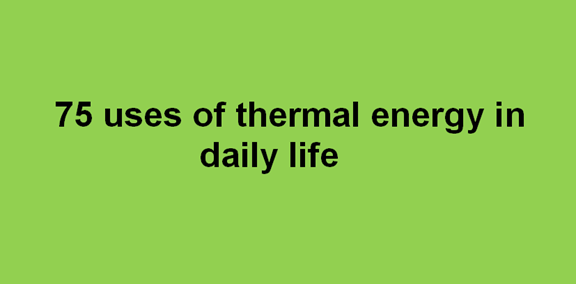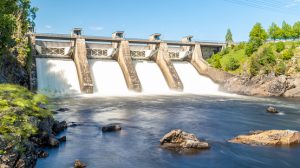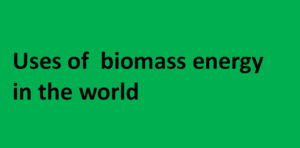Thermal energy is vital for the survival of all living organisms. Before proceeding to the uses of thermal energy, let’s first understand what thermal energy is. The definition of Thermal energy is twofold, ‘Energy’ and ‘Thermal.’ – Energy can be defined as the ability to work, which introduces another word ‘work.’ Work is the movement of an object due to the applied force.
According to Merriam – Webster dictionary, thermal is defined in threefold, the first definition is ‘of relating to or caused by heat it’s also defined as ‘involving a state of matter dependent upon temperature,’ and thirdly it’s, ‘having low energies of the order of those due to thermal agitation.”
Wikipedia defines thermal energy as, “Thermal energy can refer to several distinct thermodynamic quantities, such as the internal energy of a system; heat or sensible heat, which are defined as types of energy transfer (as is work); or for the characteristic energy of a degree of freedom in a thermal system”
From this definition, we can deduce that thermal energy is the ability of something to ‘work’ due to the movement of particles.’ Thermal energy is a type of kinetic energy (energy in motion); it results in a measurable change in internal temperature. The difference in temperature is pegged on how fast the particles move in an object or system.
You shouldn’t be confused with this winded definition. Let’s use a live example to clarify what thermal energy is when you connect an electric kettle to a power socket. The element in the kettle heats up due to electric energy causing the molecules in the element to move faster. This movement produces heat, which is released by the element into the kettle.
Now let’s add cold water into the kettle, the heat produced by the element is transferred into the water, the water molecules start moving as the heat increases, they move faster and faster, and reach boiling point, where they separate and the water turns into steam. The transfer of thermal energy from the element to the water is what’s called heat.
The production of steam is due to an increase in internal energy in the water molecules, and the heat produced results in an increase in temperature. The energy that is produced by the rise of temperature is what’s known as ‘Thermal energy’ also called ‘heat energy.’
The uses of thermal energy can be classified by their distinct sources, how it is produced, and the uses – where it is applied for example biomass fuel like wood when burnt produces thermal energy that can operate steam boilers which in turn is your used to produce industrial products.
The following are common sources of thermal energy:
1. Biomass Thermal Energy
2. Solar Thermal Energy
3. Mechanical Thermal Energy
4. Electrical Thermal Energy
5. Fossil Fuels
6. Geothermal Energy
Thermal energy produced by these processes is used from different applications both domestically and industrially. Here are the uses.”
Biomass Thermal Energy
Wood thermal energy is the most prolific in developing countries where over 2.5 billion people rely solely on wood energy for both domestic and industrial uses. Wood that is mostly used is logs, branches, twigs, wood products like discarded timber, and sawdust. Many households and industries burn the wood to produce thermal energy which is used in the following applications;
1. Dry wood is used in traditional stoves for combustion to produce thermal energy for home cooking, water boiling, and other domestic heat uses.
2. Wood logs are buried in a pit or a kiln, covered and burnt without oxygen, to produce charcoal. The heating value of charcoal is higher than raw wood, besides being cleaner than firewood. Charcoal is used to produce thermal heat for cooking, boilers, heating, and many other domestic uses.
3. Dry wood mostly conifers and spruce burn quickly; they are used to produce a lot of heat that is used as thermal energy for bread ovens.
4. Open fireplaces and boilers use hardwood logs that burn more slowly and produce consistent heat. The thermal energy produced is used to boil water for steam production and other industrial uses.
5. Ceramics, tiles, and bricks need thermal energy to convert and harden. Wood is still is basic thermal energy producer used for this application.
6. Many Industrial products such as paper and paperboards need a high amount of thermal energy that comes from burning wood, which produces the required heat.
7. Steam cleaners burn wood to produce heat, which is used to heat water past the boiling point. This steam is pressurized through a nozzle, and the thermal energy produced used to loosen dirt, kill dust mites, molds, and any other harmful allergens.
8. Wood fired boilers are also heated to heat water, the steam produced is used to run a turbine that produces an electric current.
9. Thermal energy used can also be extracted in the industrial applications in a heat transfer method. Where a fluid mostly water is allowed to circulate and used to conduct heat away from the machinery, and other items.
10. Biomass fuels can also be converted into combustible producer gas. Wood, Pellets, or charcoal is put in a combustion chamber and heated intensely in a process called gasification. The heat converts the biomass into producer gas.
11. Thermal energy is also used to convert wood, agricultural waste, and charcoal waste to produce briquettes in a process called densification. The wood residues and charcoal are carbonized, thermal energy converts them into briquettes.
12. Liquid fuel can be produced through hydrolysis with the help of thermal energy which is applied to help convert the liquid extracted from various types of biomass, wood pulp, sugarcane, etc into ethanol or alcohol by a process called hydrolysis.
Solar Thermal Energy
Solar thermal energy is one of the cleanest sustainable and renewable energy on earth. Thermal energy is collected through two ways, passive solar heating, and active solar heating. The energy is collected and either stored as in passive solar heating or it’s mechanically collected and distributed.
13. Solar thermal energy is used to increase the internal energy of an element through solar radiation. It’s then transported through a liquid to where it is needed.
14. Solar collectors are also used to collect and store solar thermal energy, which is then used to heat water for domestic use.
15. Photovoltaic panels collect solar energy, are used to collect thermal solar energy and to convert it into direct current that can be used as AC electric power.
16. Solar thermal energy can also be collected in thermoelectric plants and used to heat water and produce steam which is then directed to a single source to operate a turbine that produces electricity.
17. Solar thermal power is also used to heat outdoor and indoor pools, especially during winter.
18. Thermal energy from solar is used for underfloor heating and radiator heating to warm the house.
19. Another solar thermal energy use is in heating domestic water boilers make accessible warm and hot water for showering, kitchen use, and other domestic hot water uses.
20. Solar thermal is used to operate refrigeration appliances. Like air conditioning in buildings and in industrial cooling processes.
21. Solar thermal energy is an efficient way to dry grain, it uses solar electric powered process to draw ambient air which is heated and runs through the dryer, drying the grain more evenly than the natural methods.
22. Solar-powered ovens use solar thermal energy to generate heat that is used for baking bread cakes and anything that needs baking, they are efficient and safe to use for both domestic and industrial uses.
23. The solar-powered desalination plant uses solar thermal energy to modulate both photovoltaic and RO(Reverse Osmosis) systems to provide filtration of saltwater and provide clean soft drinking water.
Mechanical Thermal Energy
Mechanical, thermal energy is produced when two objects are rubbed against each other to produce friction.
24. The ancient ways of starting a fire is an excellent example of mechanical, thermal energy at work. In today’s world, it can be seen in striking a matchbox to start a fire; the mechanical friction causes a spark that lights up the match stick’s head.
Electrical Thermal Energy
Electrical energy occurs as a result of moving charged particles and is highly potent in thermal energy. Electric energy is therefore easily converted to thermal energy and used in different sectors, in industries and domestically, here are some appliances that convert electric energy to thermal energy.
25. A bread toaster is an excellent example of electric thermal energy at work, it draws electric power heats up the filaments into thermal power that toast bread to a golden brown.
26. Drying clothes in clothes dryer brings electricity into the dryer, hits a filament in the dryer as it spins, drying your clothes.
27. Another use for electrical thermal energy can be seen in electric hair straighteners, they convert electrical power into thermal energy in the comb that heats up to straighten hair.
28. An electric stove draws electricity into its elements that heat up to produce thermal energy that can be transferred into any container placed on the stove to cook a meal.
29. The electricity flowing through An electric kettle heats the element which produces thermal energy that can be used to boil tea water milk or coffee.
30. Electric cookers convert electrical energy into thermal energy and produce heat, which can be used to cook, bake, or warm food.
31. Microwave cookers operate electromagnetic radiation within the microwave frequency range. As the food in the microwave rotates, it produces thermal energy through dielectric heating, cooking or warming the food.
32. The incandescent bulb, when lighting up, produces thermal energy due to the heat-induced in the filament by passing an electrical current.
33. Thermal energy is also used when burning fossil fuel in electric power generating stations, to produce thermoelectric energy.
Industrial Thermal Energy Uses
34. Electrical, thermal energy is used in pulp mills to steam and digest the wood; it’s used for bleaching and chemical preparations, evaporation, and drying of the finished products.
35. Petroleum refineries use thermal energy in several processes, cracking, reforming, and treating. This process requires different types of thermal energy, steam and direct heat for combustion, and separation.
36. Catalytic reforming is a process where low octane gasoline and naphthas are converted into high octane aromatics through dehydrogenation of naphthas, dehydrocyclization of paraffin to aromatics, isomerization, and hydrocracking. All these processes require thermal energy.
37. Steel and iron industries use thermal energy to manufacture steel from iron ore by smelting with coke or limestone. The thermal energy contained in the is dissipated when the molten iron is cast into ingots and rolled into sheets by hot and cold rolling.
38. Paper Mills require a high amount of thermal energy to dry their products. They use heat in forms of hot air and steam, which is produced from electricity. Many paper mills have heat recovery cogeneration, and the steam trap traps thermal energy and recycles it for efficiency.
39. Paperboard Mills use thermal energy to dry their products and to press the boards. They use to heat hot air and steam from boilers produced from electricity. Many paper mills have heat recovery cogeneration, and the steam trap traps thermal energy and recycles it for efficiency.
40. Industries use natural gas, electricity, petroleum, and coal to produce thermal energy which is used to heat industrial processes and space heating in buildings the thermal energy fires boilers and is used as feedstock.
41. Ethyl Alcohol manufacturing requires ethanol energy during distillation. Thermal energy is required in different stages, Pretreatment drying and conditioning of corn, steam is used in distillation, water is required during cooling to dissipate the excessive thermal energy.
42. Plastics fibers adhesives and rubbers are processed using thermal energy. Commonly known as polymers, they include automobile parts, aircraft parts, coffee cups foam, and many more.
43. Petrochemical industries use thermal energy in cracking natural ethane, and propane into olefins like ethylene and propylene and aromatics like benzene and xylene isomers produced by catalytic reforming.
44. Chlorine is manufactured by electrolysis which involves passing an electric current through a solution of brine to release thermal energy that transforms the compounds caustic soda and hydrogen.
45. Nitrogen fertilizer is manufactured from ammonia, ammonium nitrate and urea, which is processed by the use of thermal energy under high pressure.
46. Corn wet milling uses thermal energy to break corn kernels into corn oil, protein, corn starch, and fiber.
47. Cement is manufactured from breaking down of limestone through the application of thermal energy
48. Potash is produced by applying thermal energy through electrolysis to break the chemicals into water-soluble ash.
49. Blanching is a process that involves low thermal energy vegetable preservation and other food processes in the food industry. It’s also used in a wide range of industries.
50. Many industrial processes require heat transfer through fluid thermal energy transferred helps in heating and cooling during production.
Fossil Fuels
51. Motor gasoline burns to produce thermal energy that can be used to power different types of machinery, including running turbines to produce electricity.
52. Kerosene type jet fuel burns to produce excessive thermal energy that converts into thrust to propel an aircraft forward.
53. Hydrocarbon gas liquids are versatile and are burnt to use in industrial, domestic and agricultural uses the thermal energy produced is used for heating, cooking and industrial processes.
54. Distillate fuel is used to heat and run engines in motor vehicles such as buses, and other commercial vehicles, the thermal energy produced is converted into mechanical energy.
55. Petroleum coke refers to various carbonaceous solids obtained from petroleum processing. It includes rawly calcined and needle petroleum. It is burnt to produce thermal energy used to fire bricks and smelt metal.
56. The petrochemical feedstock is chemical products obtained from petroleum, they are used to process simple olefins like ethylene which is used to create thermal energy that can be used to process other products.
57. Lubricants are used to reduce thermal energy in running motors.
58. Aviation gasoline produces thermal energy used to power jet engines.
59. Waxes are by-products of petroleum refining; they are used to produce thermal energy in industrial applications.
60. Residual fuel oil is burnt to produce thermal energy that powers boilers.
61. Kerosene is burned to produce thermal energy used for cooking.
62. Asphalt and road oil is heated by thermal energy and pressed when hot on the road to creating tarmac.
63. Still, gas is lit and used to produce thermal energy for domestic and industrial applications.
Geothermal Energy
Hot springs, geysers, and other sources of geothermal power tap thermal energy from volcanic activities. This thermal energy produces hot water or steam that can be used for many uses both industrially and commercially.
64. Geothermal hot springs are harnessed to run turbines that generate electricity, converting thermal energy to electric energy.
65. Water heated directly by volcanic thermal energy is directed for use to heat buildings, heat swimming pools and can be used directly to heat spas, and other therapeutic facilities it can also be used in aquaculture ponds.
66. The thermal energy produced by Geothermal power can be directed and channeled to cook domestically.
67. It can be used commercially to dry fruits, and vegetables, and timber.
68. Thermal energy from geothermal power has successfully been used for large scale snow melting on roads and other facilities.
69. Heat exchangers are used to transferring thermal energy in machinery and boilers.
70. Geothermal heat pumps are powered by thermal energy to heat up homes and motor.
71. Geothermal heat is also used in milk pasteurization.
72. Steam coal is used as thermal coal to generate electric power.
73. Coking coal also is known as metallurgical coal, is used to produce thermal energy for steel production.
74. Thermal energy produced by Propane is used in heating homes and boiler water and for drying clothes, heating greenhouses, and livestock housing.
75. Alumina refineries use coal to produce thermal energy that is used in aluminum processing and smelting.
As you have seen the world cannot exist without thermal energy, the sun being the most important component that heats the earth giving life to every living thing. As I close do you know your body produces thermal energy from the food that you eat, it’s this thermal energy that activates the cells in your body and gives vitality.





this thing is rhe worst
dude this thning is the best
this helped me alot. Thanks 🙂
Thanks a bunch this is extra helpful!
‘Wood-burning’ steam cleaners’? Maybe in the 19th Century…….